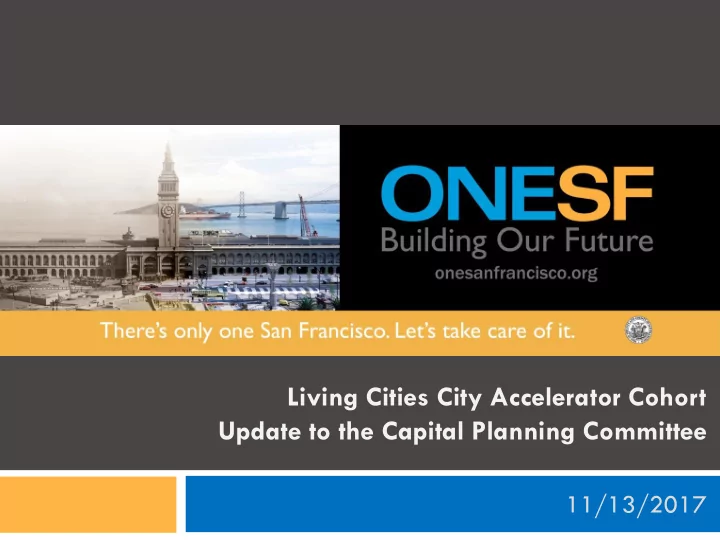

Living Cities City Accelerator Cohort Update to the Capital Planning Committee 11/13/2017
Living Cities City Accelerator Cohort Overview 2 San Francisco joined Pittsburgh (PA), St. Paul (MN), and Washington (DC) in the third cohort of the Living Cities City Accelerator program, which focused on infrastructure funding challenges Opportunity to exchange ideas and build solutions with input from partners and experts $100k award used for public outreach and research Contributed the work and findings of the Seawall Finance Work Group
Living Cities City Accelerator: Cohort Calendar 3 March 2016: Acceptance into 3 rd Cohort April 2016: Denver convening October 2016: New Orleans convening June 2017: Seawall Finance Work Group recommendations presented to CPC and the Port Commission Summer 2017: Public outreach about the Seawall at Sunday Streets September 2017: Final convening hosted by San Francisco, showcasing many of our development projects, including Treasure Island, Transbay Transit Center, and the Seawall Forthcoming: Publication of a public infrastructure financing toolkit from Living Cities informed by the work of the cohort
Vulnerability of San Francisco’s Seawall 4 Fisherman’s Wharf 1850’s Shoreline Mission Creek Pre-1906 Seawall 1906-1916 Seawall
Seawall Resiliency Project Plan 5 Port staff have envisioned 2 major phases to the Project: Phase I – seismic improvements to address the most critical life safety and flood risks at TBD, isolated locations along the Seawall Phase II – potential replacement of the entire 3 miles of the Seawall with all seismic and sea level rise adaptation measures Project Phase Budget Duration Start Finish Phase I Overview $500 million 11 years January 2015 December 2025 Vulnerability Study $1.0 million 1.5 years January 2015 June 2016 Planning $8.5 million 2.5 years July 2016 December 2018 Preliminary Design & $25.5 million 2.0 years January 2019 December 2020 Environmental Approvals Final Design & $465.0 million 5 years January 2021 December 2025 Construction Phase II Overview ~ $5 billion ~ 20 years January 2026 January 2046 Note: Project cost estimates are in 2016 dollars and do not take into account the time value of money. It is important to consider the influence inflation will have on the overall cost of repairing the Seawall over time.
Seawall Finance Work Group Report 6 Mission: Analyze and prioritize the funding opportunities for the Seawall Resiliency Project Recommended local, state, and federal strategies to meet the $500M Phase 1 and the multi-billion-dollar Phase 2 needs
Seawall Finance Work Group Membership 7 Chair: Office of Resilience and Mayor’s Office Capital Planning Office of Economic and Board of Supervisors Workforce Development City Administrator’s Office – Port of San Francisco Risk Management Program SFMTA Controller’s Office – Office of Private sector financial expert Public Finance
Living Cities Grant: Focus Groups & Online Surveys 8 Engaged FM3 to conduct focus groups and online surveys Explored perceptions of various income and demographic groups Trust in government Knowledge of the seawall Willingness to invest in infrastructure Learned that education about seawall increased willingness to invest for all income groups This information inspired the San Francisco team to hire Civic Edge to apply findings in a hands-on setting
Living Cities Grant: Sunday Streets Outreach 9 Sunday Streets booths at the Mission, Tenderloin, and Western Addition events Focused on diverse, largely low-income neighborhoods not adjacent to the Port Inclusive, multilingual Seawall education Engaged with SF residents of all ages, including many who have limited access to online platforms Conversation about why people love the Waterfront Educated the public about the Seawall and risks Informed about the possible $350 million GO Bond measure without making an “ask”
Living Cities Grant: Sunday Streets Outreach 10 Connecting Positive Feelings about the Waterfront to the Seawall
Living Cities Grant: Sunday Streets Outreach 11
Living Cities Grant: Sunday Streets Outreach 12 In-Person Connections 3,000+ residents engaged 2,750 palm cards given away 535 participants in the activity 356 new email subscribers Online Connections Posted via the Port’s Facebook, Twitter and Instagram accounts 79,111 San Francisco residents – 1 in 10 people who live in the city – reached via social media 30,479 residents via organic Facebook posting 24,357 residents via paid Facebook posting 24,275 residents via organic Twitter posting
Next Steps 13 Bond Planning Finalize bond amount and scope at CPC as part of the off- year Capital Plan update Develop legislation, report, and question
Questions & Comments 14 Office of Resilience Port of San Francisco and Capital Planning Elaine Forbes, Executive Director Brian Strong, Chief Resilience Officer Meghan Wallace, Finance and Heather Green, Capital Planning Director Procurement Manager
Recommend
More recommend